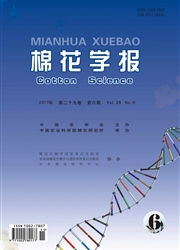

 中文摘要:
中文摘要:
试验研究表明,取食不同食物斜纹夜蛾幼虫的发育历期、存活率、蛹重和成虫的羽化率有显著的差别。取食人工饲料的幼虫发育历期最短(18.11d),其次为取食甘蓝和大豆(20.13d和20.45d)。取食人工饲料幼虫存活率达91.80%,显著高于取食棉花(75.47%)、甘蓝(73.68%)和大豆(72.22%)的处理。幼虫取食人工饲料、甘蓝、棉花和大豆的成虫寿命和产卵前期没有显著性差别,但成虫的产卵期、产卵量和卵的发育历期有显著不同。取食人工饲料成虫的飞行能力显著高于取食甘蓝的处理,而以取食大豆和棉花处理的飞行能力最差。鉴于较差的幼期营养条件并不导致成虫飞翔能力的增加,斜纹夜蛾的远距离迁飞是成虫对羽化后所处不良环境的行为反应。
 英文摘要:
英文摘要:
Effects of host plants on larval developmental duration, pupal weight, fecundity and flight a- bility of the common cutworm Spodoptera litura, were investigated in the laboratory. The experimental results indicated that there were significant differences in larval developmental duration and survival rate, pupal weight and adult eclosion while the larvae fed on different host crops. The individuals that fed on the artificial diet presented a larval developmental duration of 18.11 d, which was significantly shorter than those on cabbage (20.13 d), soybean (20.45 d), and cotton (20.76 d). The larval survival rates on the artificial diet (91. 80%) were significantly higher than thse on cotton (75.47%), cabbage (73.68%) and soybean (72.22%). However, there were no significant differences in the adult longevity and previposition period among the four treatments. The fecundity for the adult from the artificial diet reached to 2141 eggs per female, which was significantly higher than these on cabbage (1879.5 eggs), cotton (1855 eggs), and soybean (1789.5 eggs). Based on a 15-hour tethered-flight test of the adults, moths from the larvae reared on the cabbage could have a much stronger flight than those from the soybean and the cotton, although it was slower than that from the artificial diet treatment. For the three-days-old moths, the adults from the larval reared on the cabbage could fly 6.77 h and 29.0 2 km, which were significantly higher than those from the soybean by 4.88 h and 18.58 km, and from the cotton by 5.18 h and 18.97 km. These results suggest that the moths from the best host plants in larval stage possess stronger flight ability than those from the poor hosts and migratory activity of the pest, a direct behavior response of the adults to poor environment.
 同期刊论文项目
同期刊论文项目
 同项目期刊论文
同项目期刊论文
 Laboratory evaluation of flight activity of the common cutworm, Spodoptera litura (Lepidoptera: Noct
Laboratory evaluation of flight activity of the common cutworm, Spodoptera litura (Lepidoptera: Noct Flight-mill performance of the green lacewing, Chrysoperla sinica (Tjeder) (Neuroptera: Chrysopidae)
Flight-mill performance of the green lacewing, Chrysoperla sinica (Tjeder) (Neuroptera: Chrysopidae) Flight performance of the soybean aphid, Aphis glycines Matsumura (Hemiptera: Aphididae) under diffe
Flight performance of the soybean aphid, Aphis glycines Matsumura (Hemiptera: Aphididae) under diffe Does the onset of sexual maturation terminate the expression of migratory behavior in moths? : A stu
Does the onset of sexual maturation terminate the expression of migratory behavior in moths? : A stu Trade-offs between flight and reproduction in the soybean aphid, Aphis glycines Matsumura (Hemiptera
Trade-offs between flight and reproduction in the soybean aphid, Aphis glycines Matsumura (Hemiptera 期刊信息
期刊信息
